Best gaming keyboards in 2021
The best gaming keyboard for your setup will mean understanding your typing needs and preferences deeply before you buy. Beyond basic beige scissor switches, in the realm of more advanced mechanical boards, you're looking at an entirely new level of gaming experience. Once you find your perfect fit, every interaction with your PC will leave you brimming with phenomenological delight.
There are keyboard switches in all flavors and colors, so here's the skinny on the best mechanical keyboard switches around.
The sweet, slick key press of your favoured mechanical switch will have your fingers feeling less fatigued, your response times swifter, and your key presses more absolute. There's also room for much more personalisation than a rubber dome keyboard could deliver. From smooth linear action, to typewriter-esque click clacks, and a range of RGB lighting configurations, there's something for everyone in the land of mech boards.
We've been over what style of keyboard is right for you, so check that out if you're tossing up between a full-size, TKL, or 60 percent board. There are countless combinations, but these are our pick for the best gaming keyboards you can buy today.
Alternatively, if you can't quite justify the cost of one of these bad boys, the best cheap gaming keyboards wont break the bank, but you may find them lacking the competency you'll find here.
Best gaming keyboards 2021
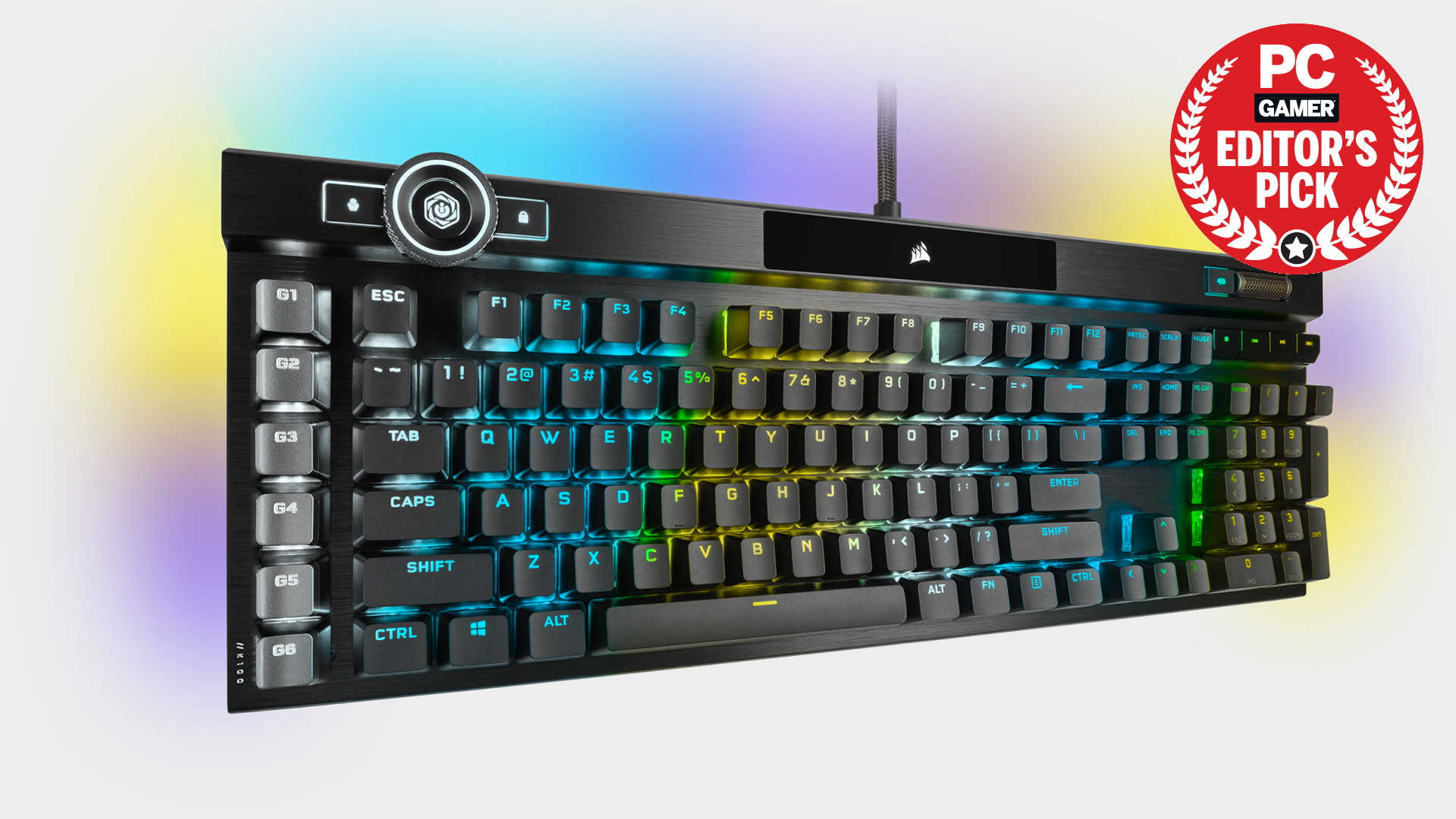
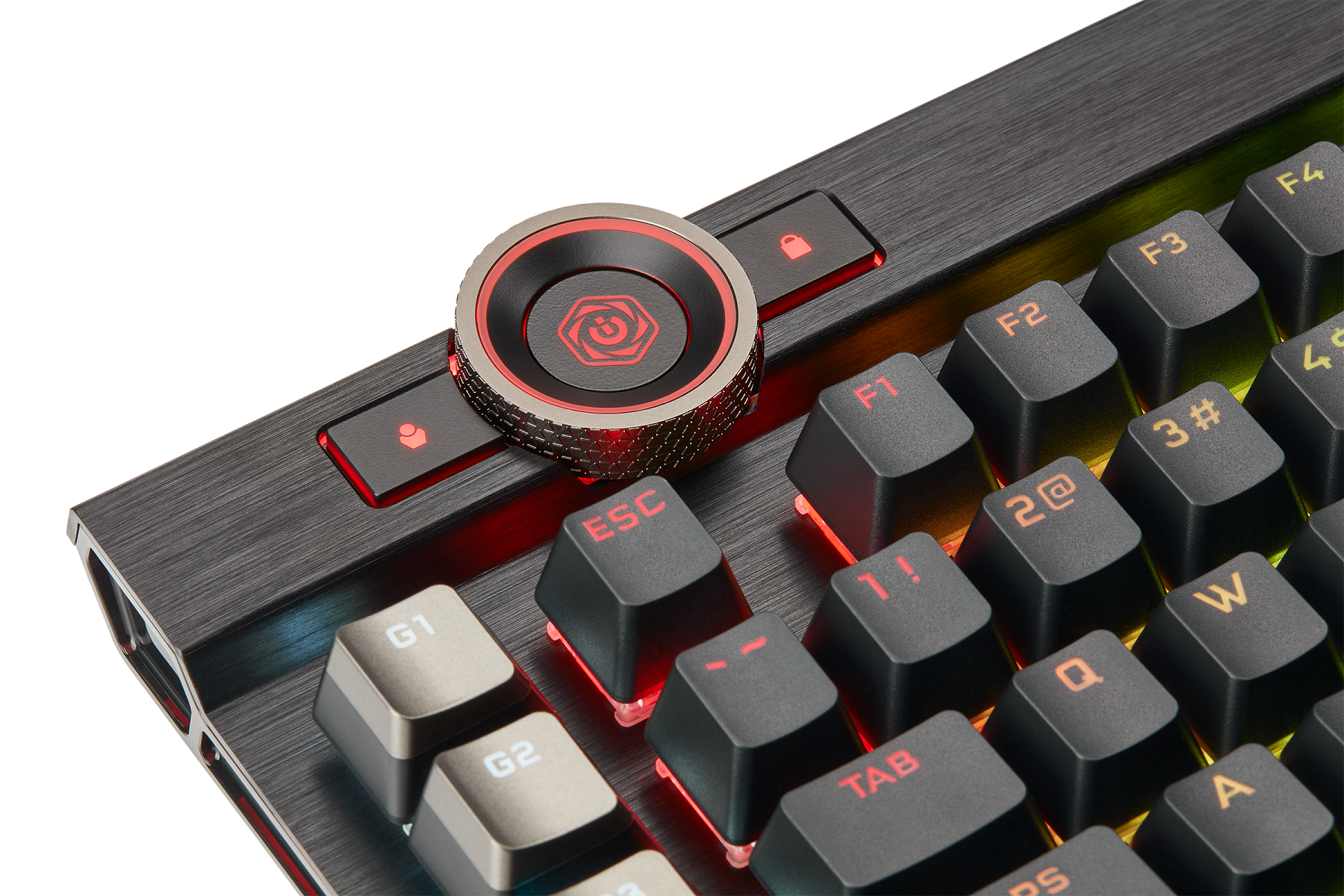
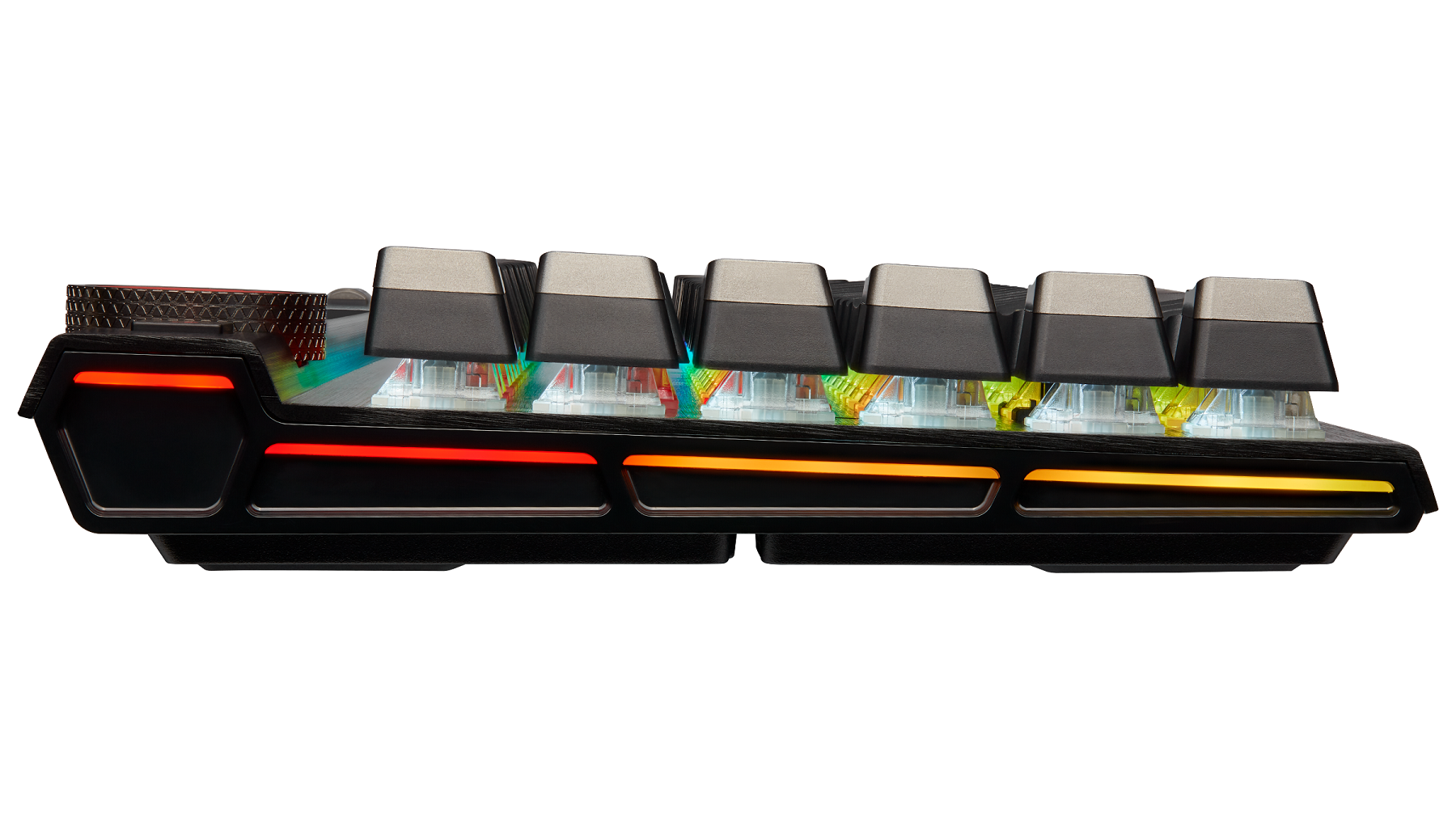
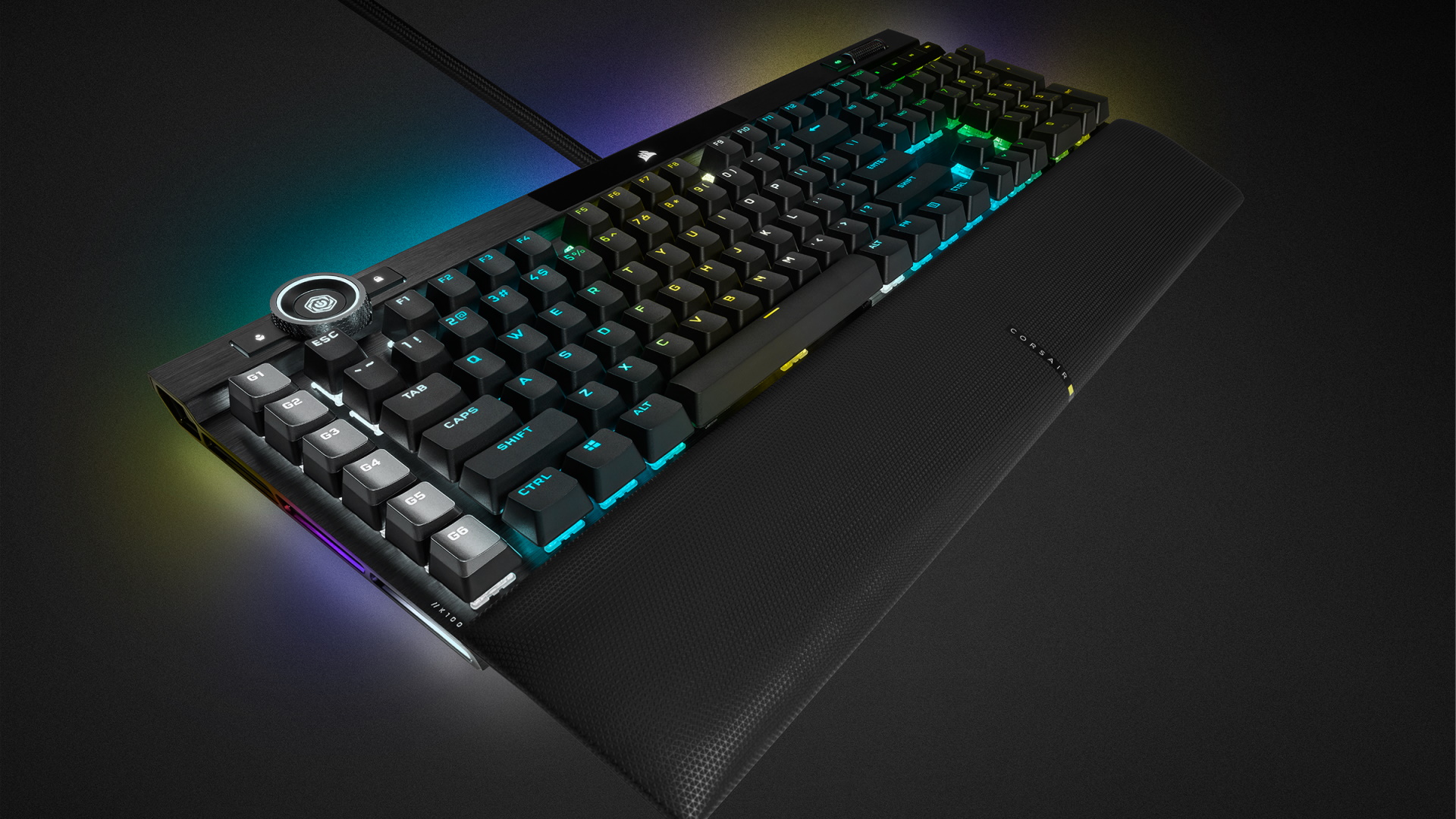
When you want to go the extra mile and upgrade to the absolute best of the best, it's hard to find a more premium option than the Corsair K100 RGB. Be warned, though; this is a big keyboard: its enormous footprint still requires some desk clearing before it can be nested comfortably. But feature-wise, the K100 RGB's got it all. Dedicated media controls and a USB pass-through, a metal volume wheel, RGB lighting. Speaking of RGB, there is an aggressive amount of RGB in this keyboard.
During our tests, we noted excellent key responses, a decent spread of keys for most hand sizes, a satisfying tactile click to each press, and wonderfully dimpled keys to help you rest your fingers when you're not actually pressing down. While this all seems quite obvious, it shows that the K100 RGB nails the basics, as well as including the fancy extras, and that's why it's top of the list.
Read the full Corsair K100 RGB Optical review.
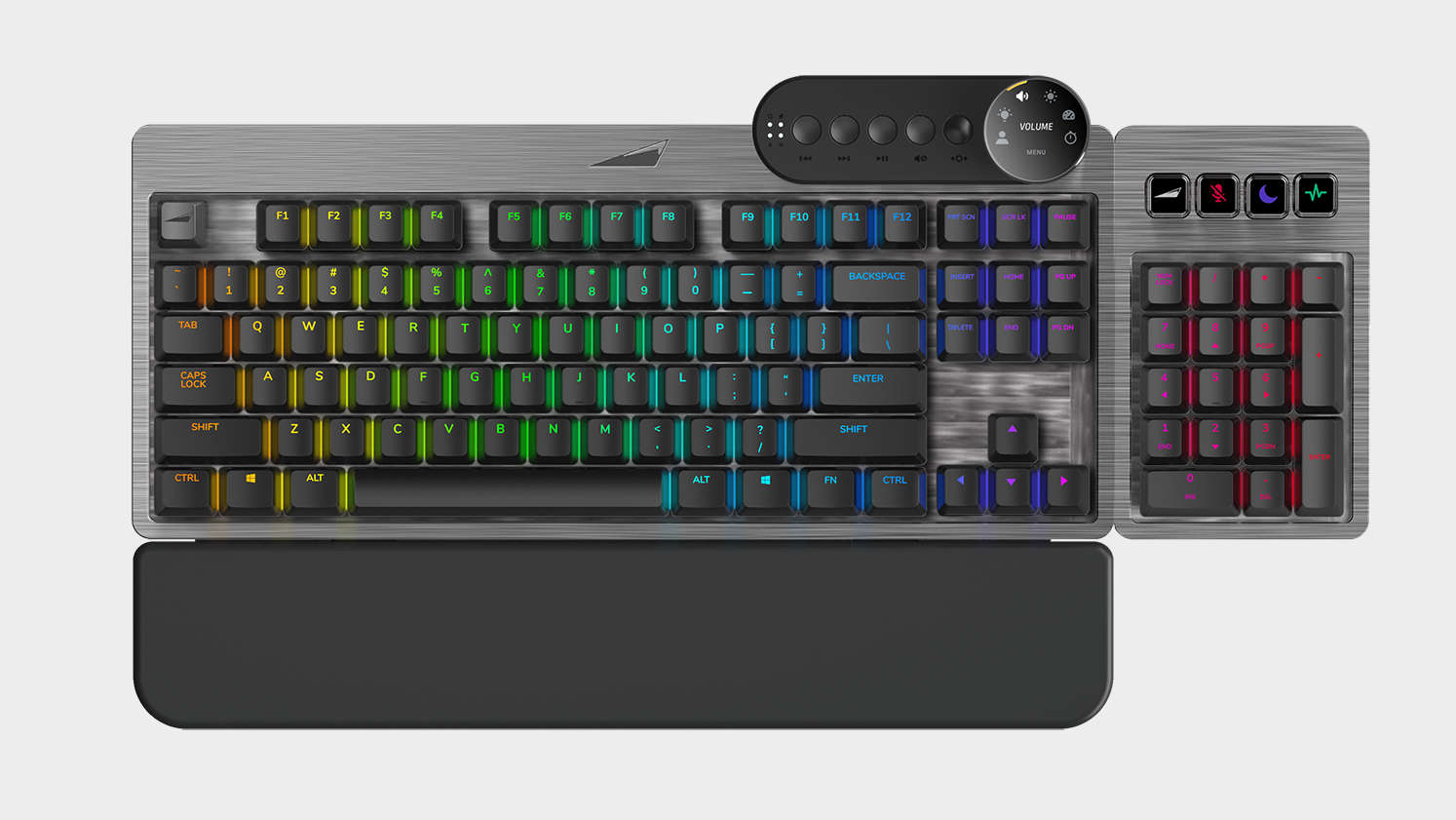
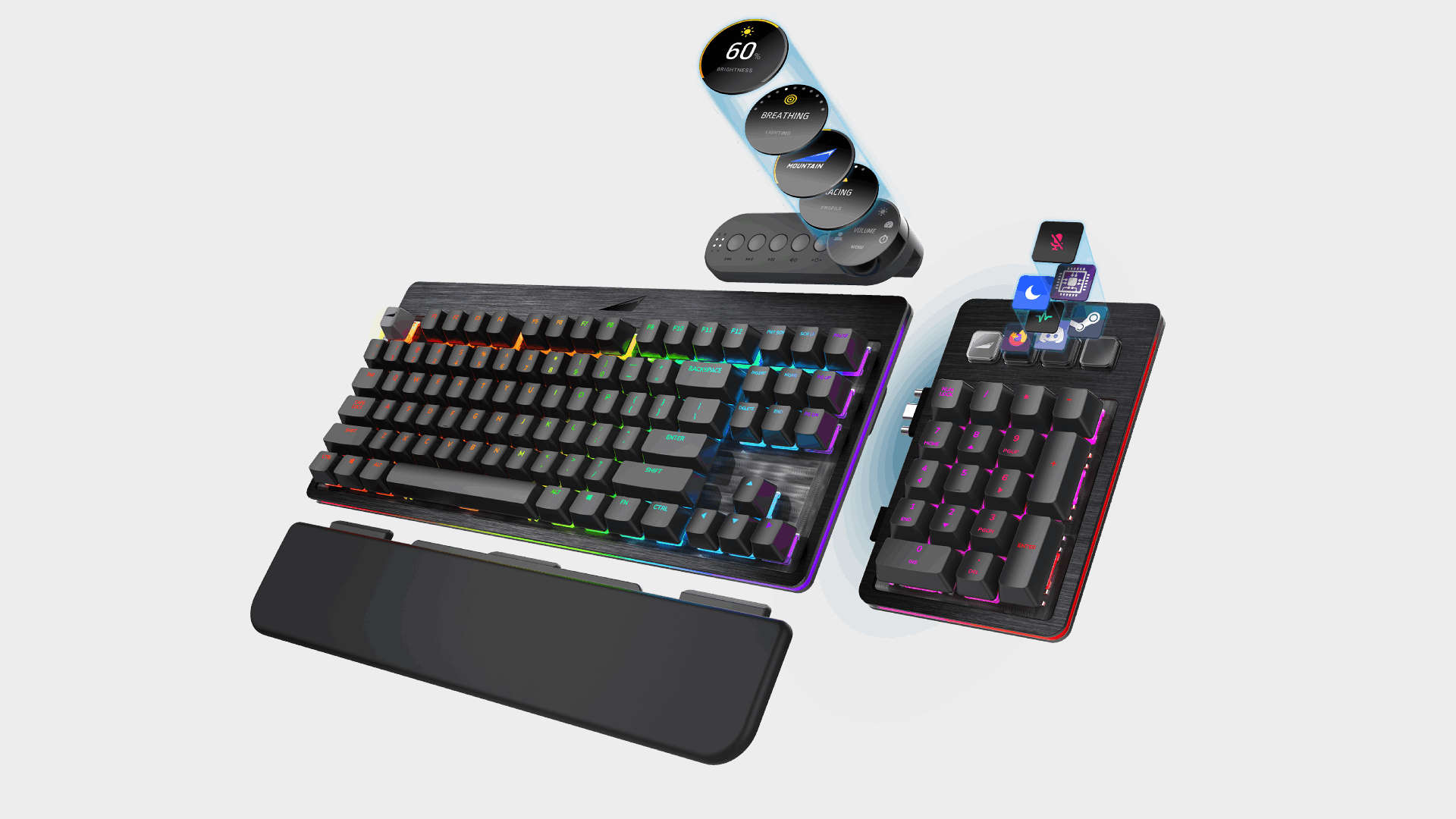
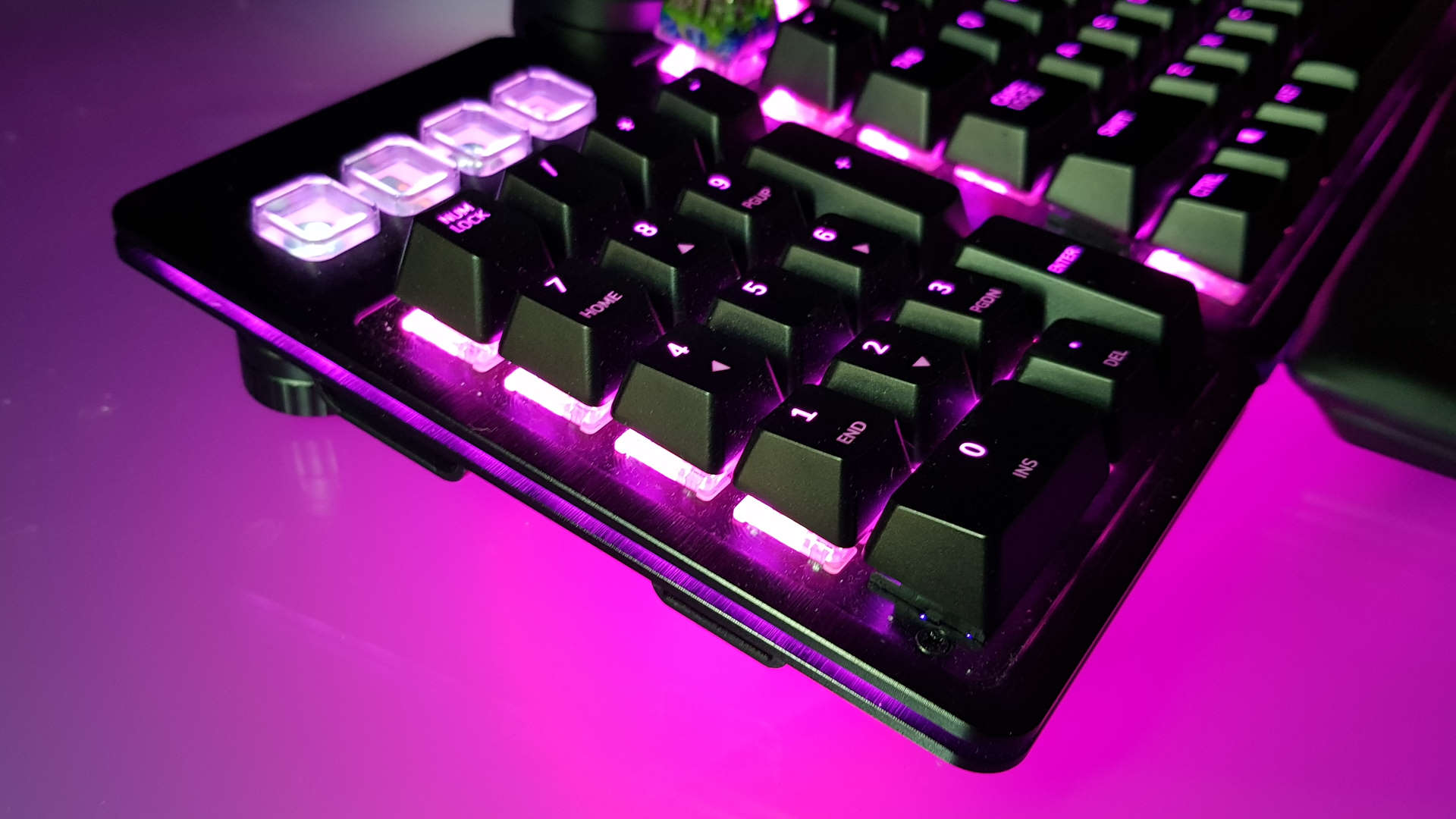
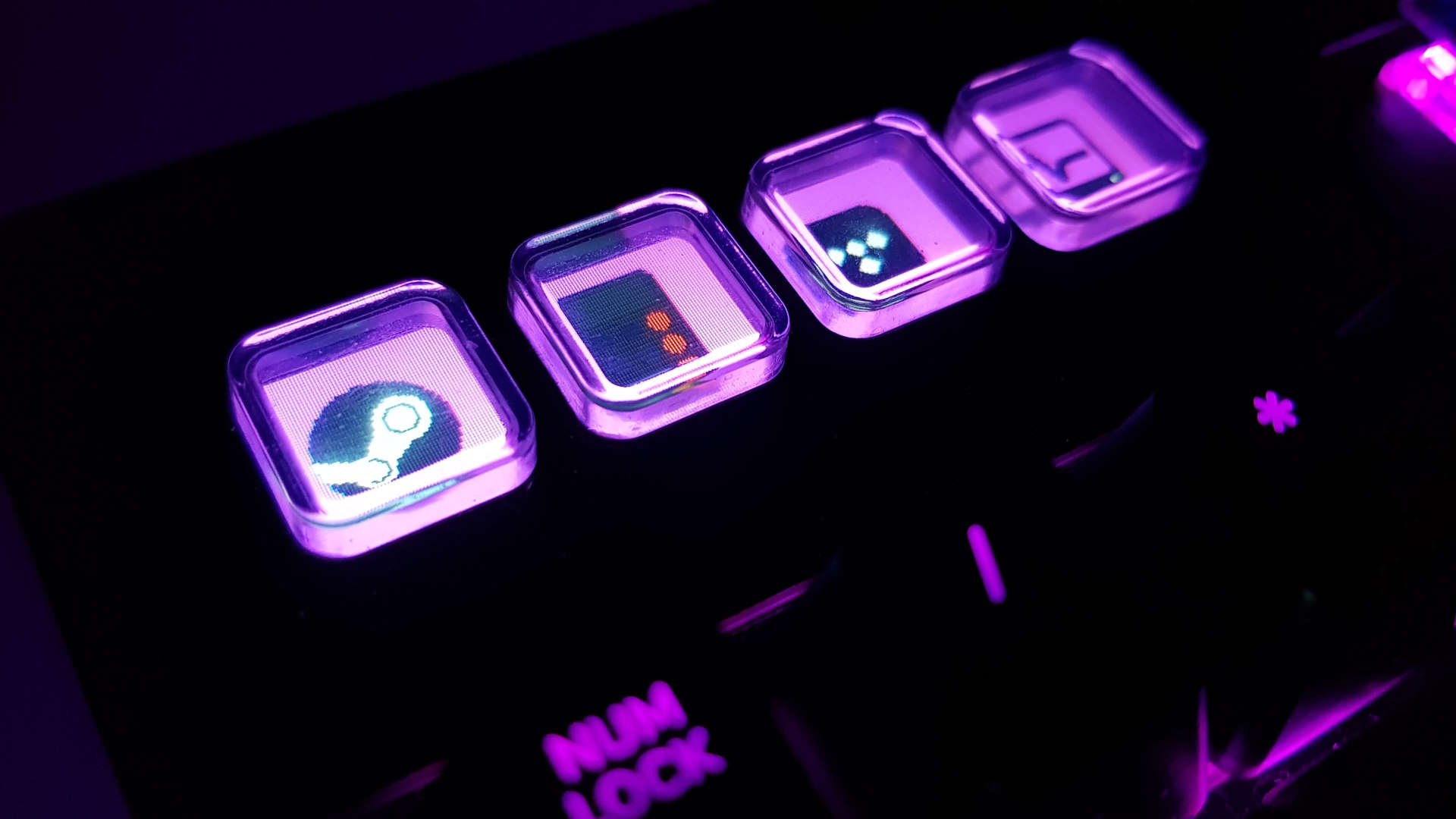
All things to all people, that's almost what the Mountain Everest Max gaming keyboard represents. And it's one of my favourite designs since it first landed on my desk. I don't always need the numpad on a full-size keyboard, but it certainly comes in handy sometimes during the work day. When I'm gaming though, all I want is a compact TKL board, to get my mouse and keyboard hands closer together and give me more desktop real estate to fling around my rodent.
That's what the Everest Max offers; the flexibility to have your TKL cake and eat your numpad. Use your numpad. Whatever. Basically the magnetically attaching numpad module is able to be attached to either side of the base mechanical TKL board and is completely hot-swappable.
The admittedly very expensive $270 (£230) complete Everest Max kit also comes with a plush magnetic wrist rest and a media module with discrete controls and an LCD screen.
It's also a board for the keyboard enthusiast too, with a base that allows you to pull out switches at will and replace them as easily as just pushing them in. You can also go for the barebones board, picking your own switches and keycaps from the start to create a truly custom option.
My only reservations with the Everest Max are its high price and the initial immaturity I experienced with its config software. That's been ironed out now for the most part, and I'm still using my sample on a day-to-day basis as it totally suits how I game and work on my PC.
Read the full Mountain Everest Max review.
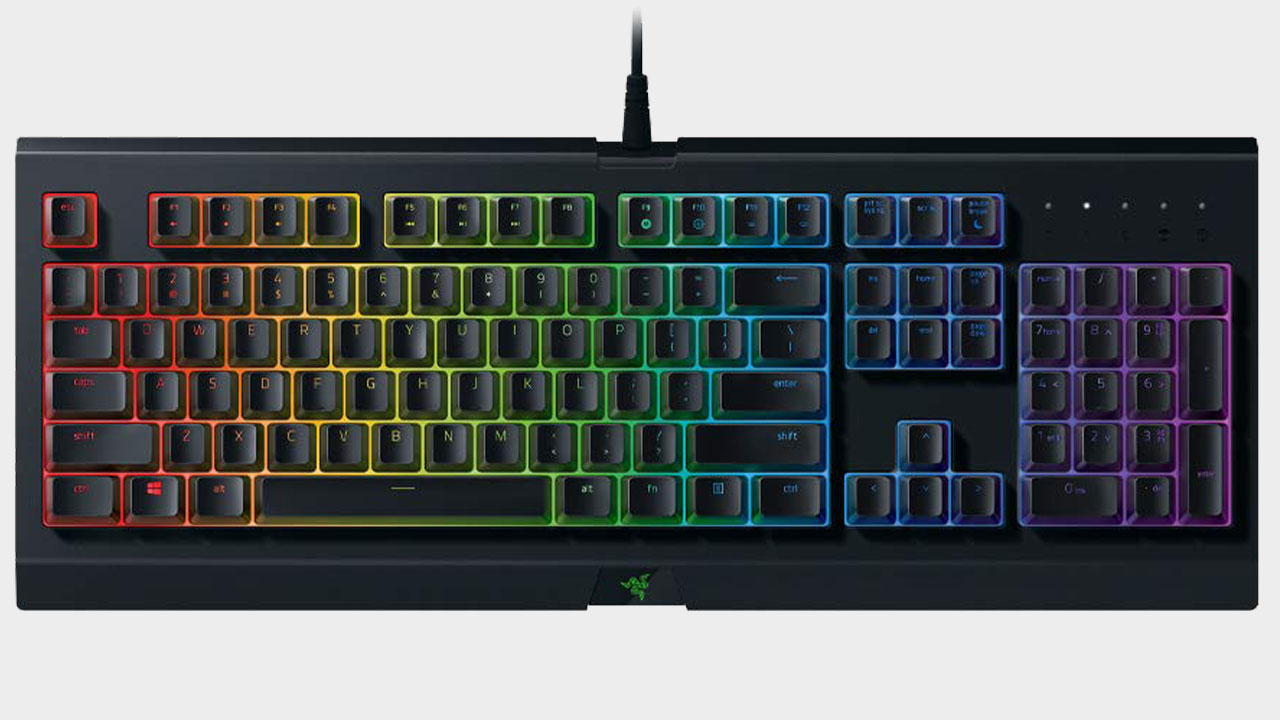
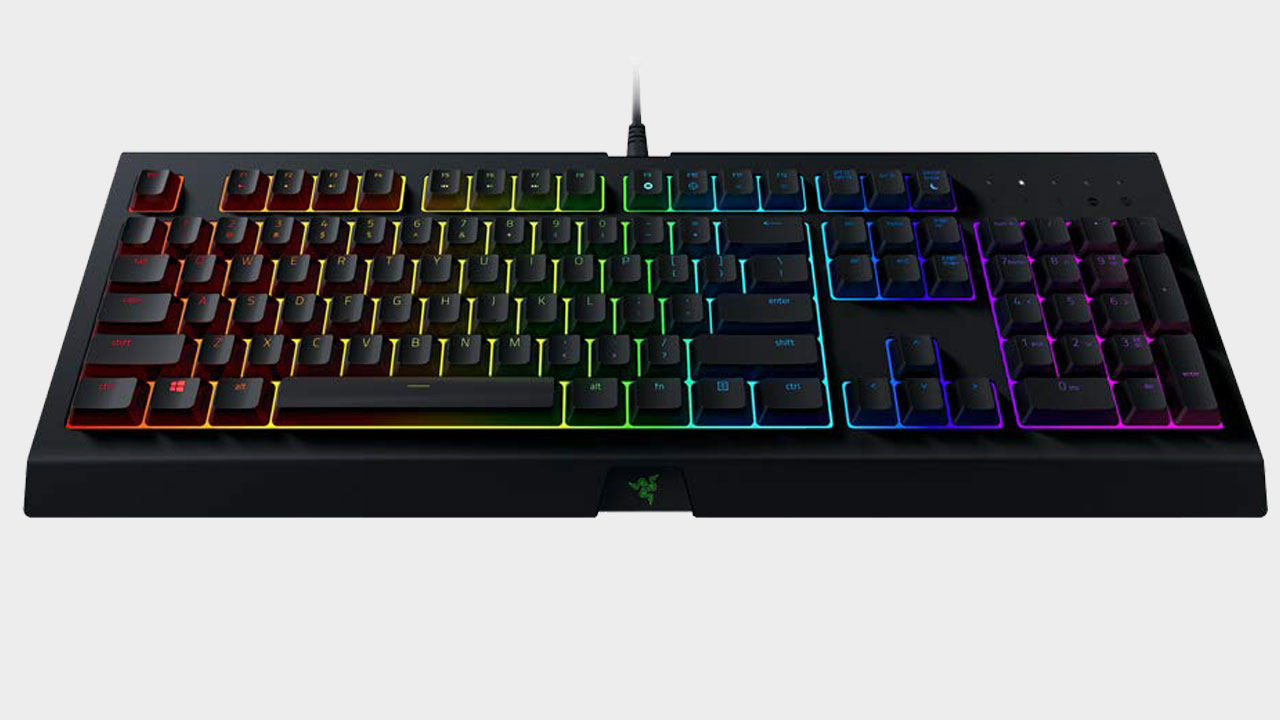
If even mecha-membrane keys don't suit you, and you demand a full membrane typing/gaming experience, the Razer Cynosa is the deck for you. I know there are people out there who prefer the soft embrace of a pure membrane switch, and that's fine—each to their own.
The Cynosa has some of the best feeling, low profile membrane keys I've ever tested, and at a retail price of $60, is one of the most affordable gaming keyboards out there (well, past a certain threshold of quality). While it may lack some of the features several gaming boards pack in these days, stuff like a dedicated wrist rest or media controls, it does boast Razer's extensive RGB lighting, which can be programmed on a per-key basis or applied by zones.
It's a solid, no-frills, nice looking keyboard that's the best membrane option of a huge range that I've tested. There is a step-up version of the Cynosa available. Still, for $20 extra, the only real addition is under-glow RGB, so unless that kind of 'ground effects' package is massively appealing to you, I recommend you save your cash and invest in the base model.
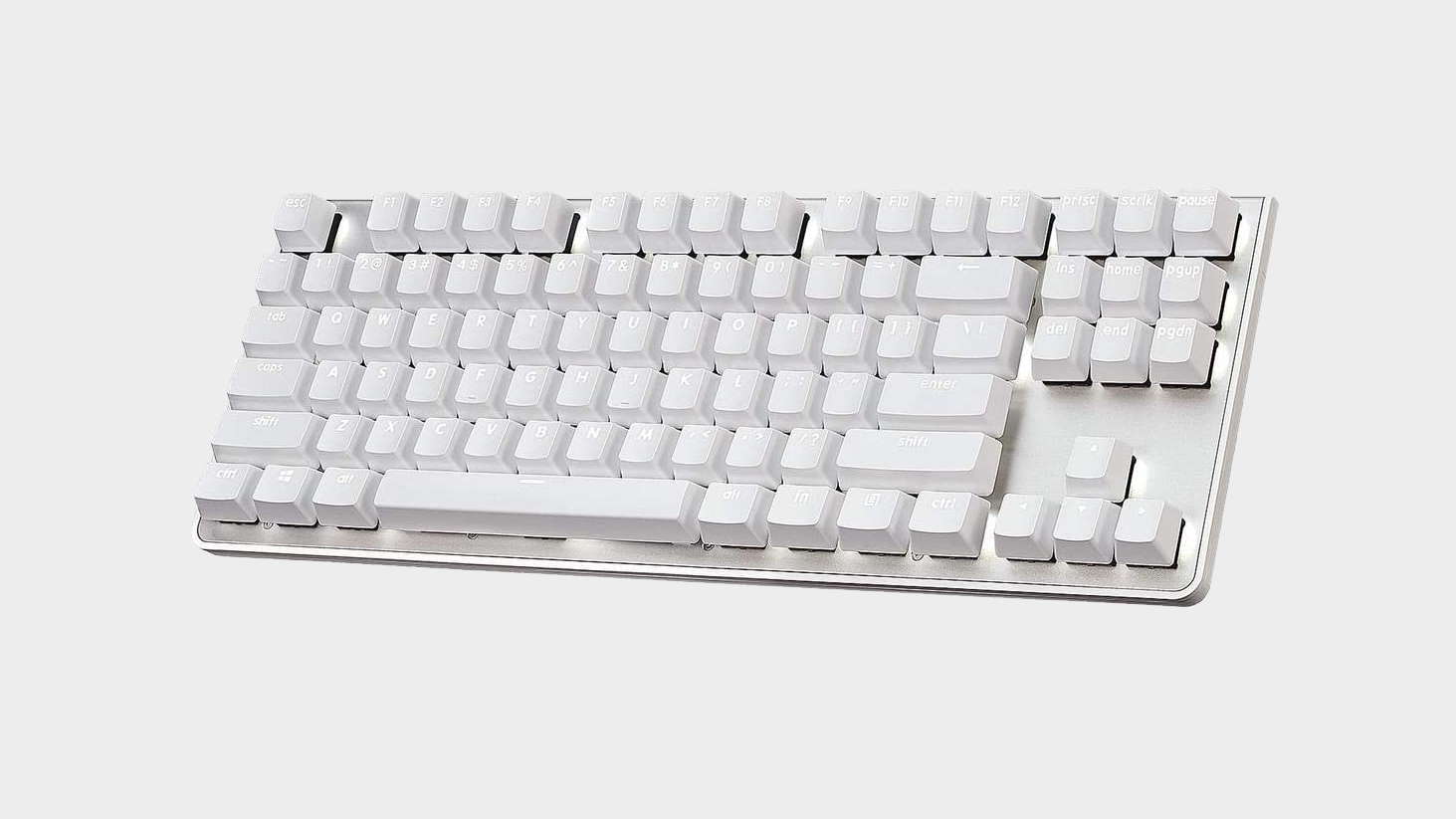
There is a trend towards $200+ gaming keyboards in the market at the moment, but that doesn't mean there aren't quality mechanical switch boards available at a more reasonable price. Often you'll find these more budget oriented options offering cheap switches from other manufacturers, but the G.Skill KM360 comes featuring the classic Cherry MX Red linear switch out of the gate.
If you can't cope with your gaming board not lit up like a rainbow then you may be disappointed with the single-colour option, but damn, the white LEDs on this G.Skill board are the brightest I've ever seen. Normally I like to keep at max brightness all day long, but the KM360 would burn out my retina if I did.
This TKL board is basic, but what it does, it does very well. It's solid, well-built, reliable, and looks pretty decent too. There's no wrist rest, no passthrough, or media controls, but I'll happily give it a pass in favour of affordable functionality.
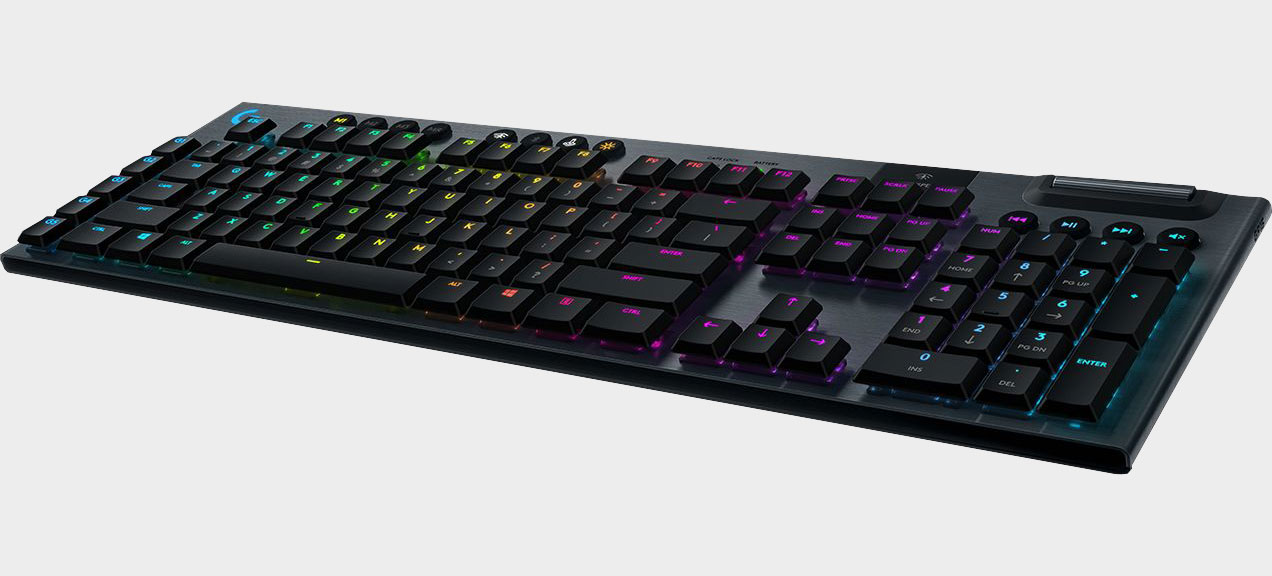
If you must pick up a wireless keyboard then the Logitech G915 is a fine candidate. You'll be required to spend that little bit more for wireless functionality over what we tend to see for wired mechanical keyboards with similar features—the Logitech G915 is $250 (£210). There's a slightly cheaper TKL version, but not so much so that we'd instantly recommend it over the full-size model.
What you get for that significant cash investment is a sleek and sturdy board plated in brush aluminium. There's some smart media controls in the upper right-hand corner of the board, including a lovely volume wheel, and there's a handful of macro keys down the left-side of the keyboard. These can be programmed to whatever you see fit on a per-app or per-game basis from within the Logitech G software.
Beneath that stylish exterior lies fantastically responsive Kailh-made GL key switches. You can pick from linear, tactile, or clicky, and we recommend the latter if you really want to make a racket.
It packs in all this without massive overall footprint, too, coming in as one of the sleeker boards of the lot today. The wired Cherry MX 10.0 has it beat there, though, for better or worse.

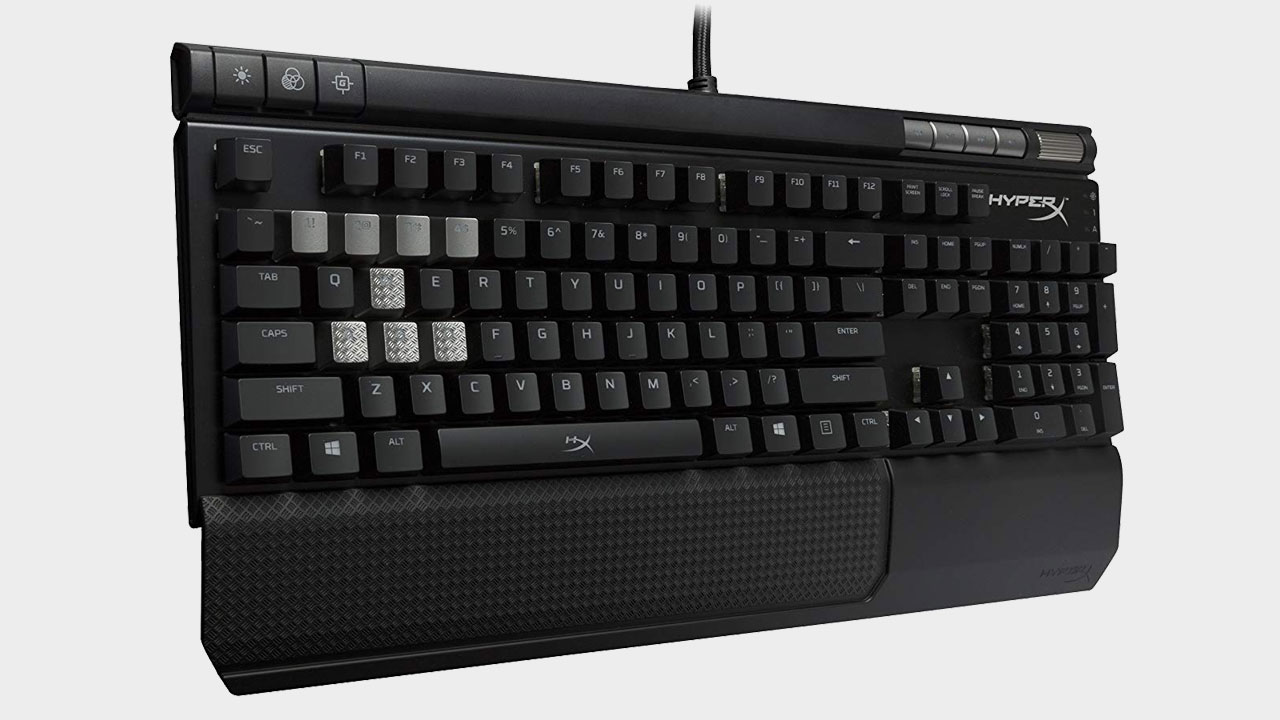

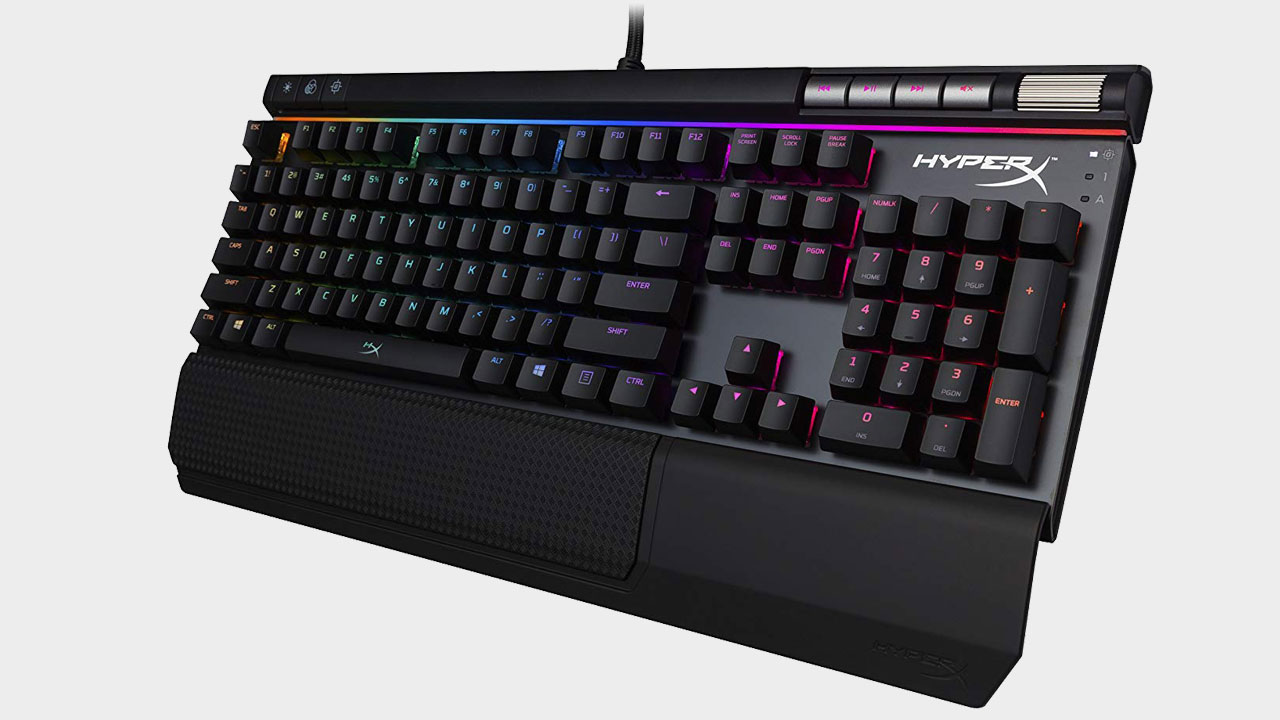

For a board that can be illuminated in up to 16.9 million colors, the HyperX Alloy Elite sports a relatively simple aesthetic while still packing the features we expect out of a quality gaming keyboard. It comes in your choice of Cherry MX Brown, Blue, and Red. What it lacks in a dedicated macro column, it makes up for with its reasonable price and quality, durable design.
The HyperX Alloy Elite RGB leaves no feature box unchecked. It's equipped with dedicated media controls, USB passthrough, a detachable wrist-rest, and full RGB backlighting. It also includes an extra set of silver keycaps for WASD and the first four number keys to up its aesthetics. The board supports full N-key rollover, meaning you never have to worry about key presses not registering.
The new HyperX Alloy Elite 2 has now been launched, featuring some gorgeous ABS pudding keycaps, but only seems to be available on the HyperX website right now. It is damned pretty, but you don't get the wrist rest... you win some, you lose some.
Best gaming mouse | Best gaming chair | Best gaming PC
Best VR headset | Best wireless gaming mouse | Best gaming monitor
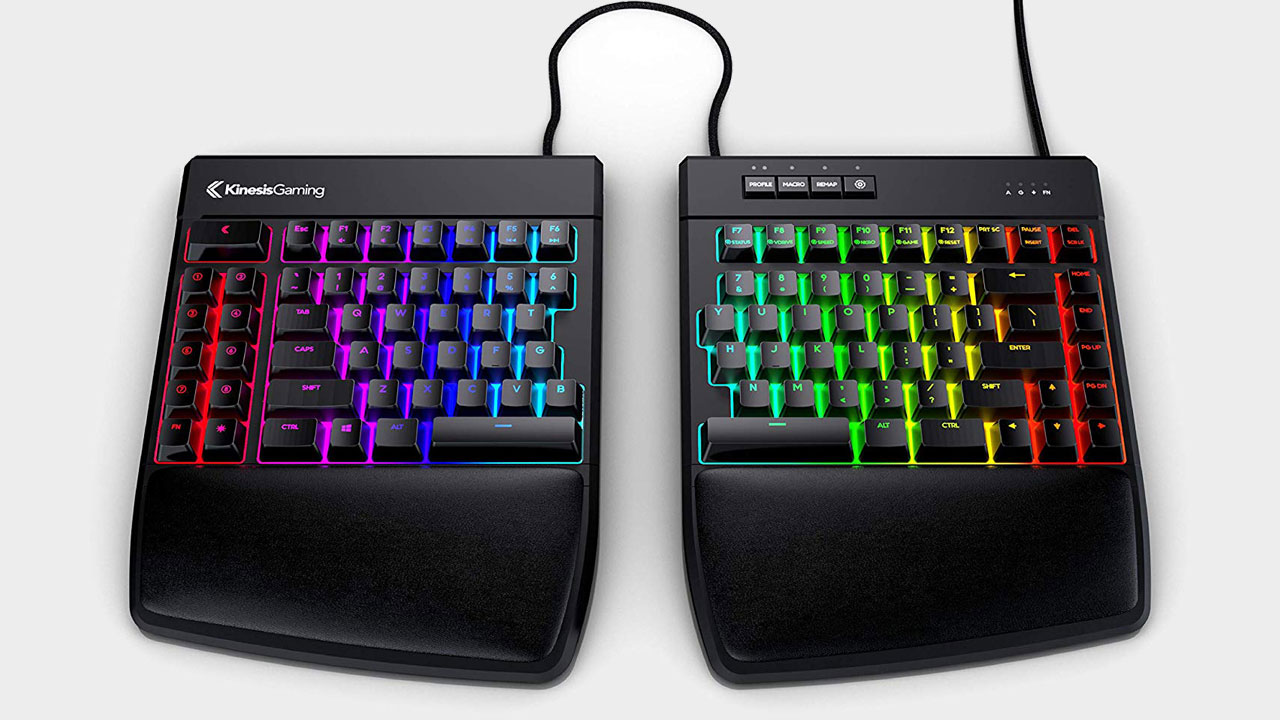
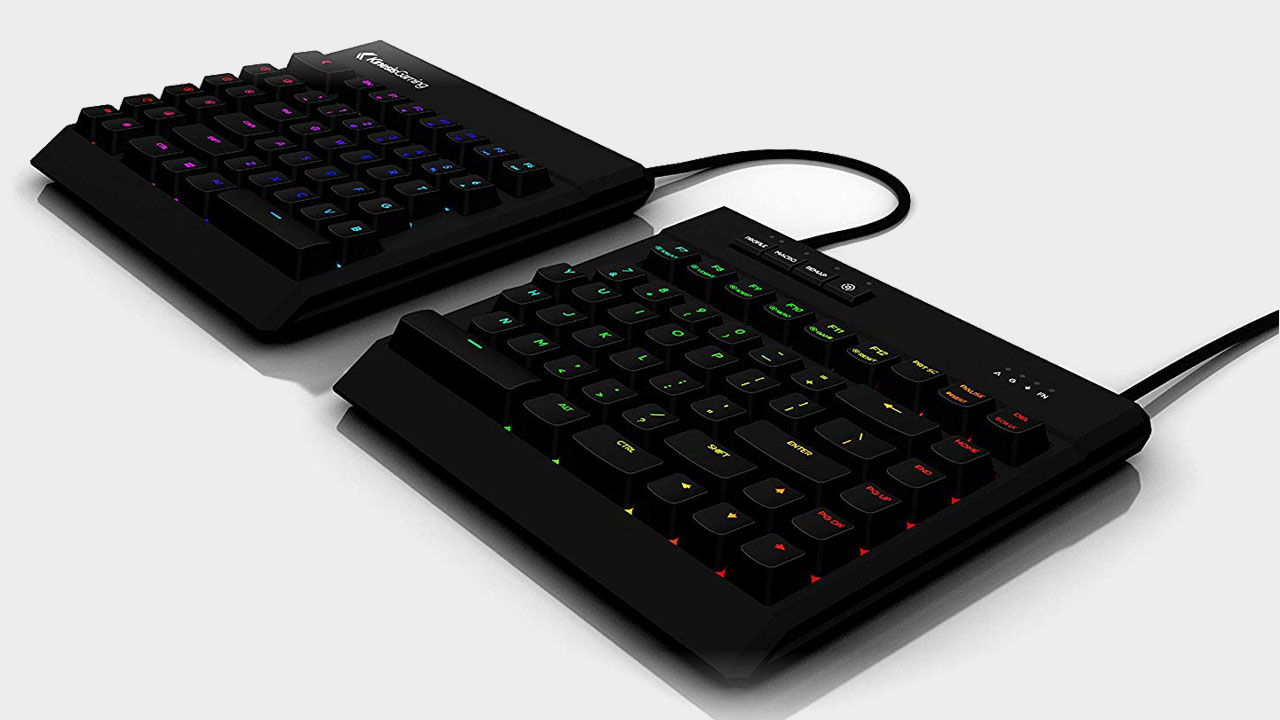
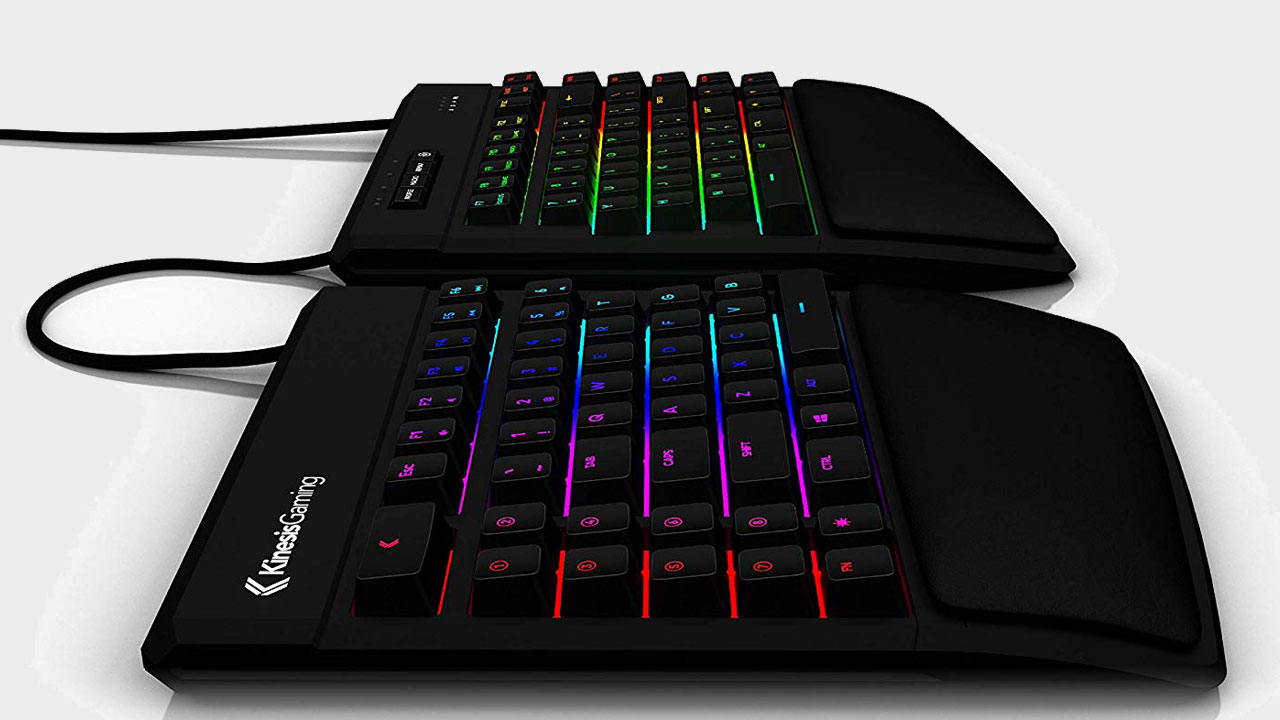
The original Freestyle Edge from Kinesis was one of the best split ergonomic keyboards on the market. This upgraded RGB model improves on the original in several ways. It retains the split design, allowing you to set the deck's two halves at shoulder width and reduce back, neck, and shoulder strain. The gap also lets you drop a flight stick or HOTAS in between them for space sims or leave your controller within easy reach when you're typing in text chat or messengers between sessions.
The Freestyle Edge RGB is also customizable, with onboard storage for up to nine user profiles, ten dedicated macro keys on the left half, and the ability to customize every key individually (including on the entire layer that you access by pushing the Fn key). It's fully programmable without the use of any additional software, though it can also be customized through Kinesis' Smartest software for an even more granular experience.
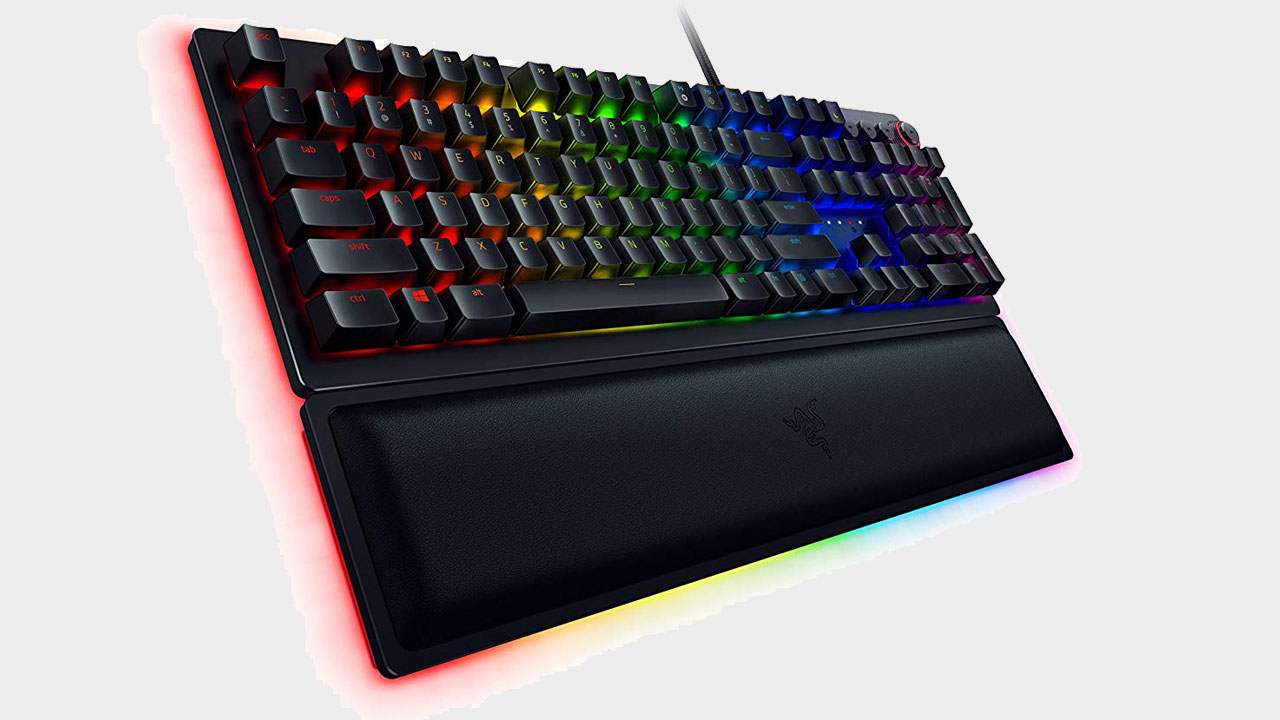
The Huntsman family of Razer keyboards is the only place in the world to find their optomechanical switch, and it's one of the best (and most technologically interesting) switches on the market. The optomechanical build eschews traditional metal contacts and instead actuates by a beam of light that fires through the switch when the key is depressed, meaning actuation is almost instantaneous.
The other major advantage of removing all the relatively frail, slender metal contacts from the switch is that they're rated as twice as durable as standard mechanical switches, up to 100 million keystrokes. They're tactile switches that actuate at 1.5 mm and 45g of force, meaning they're ridiculously easy to spam but still provide tactile feedback. They're also great for typing for much the same reason.
The rest of the Elite is well designed too, with a comfy detachable magnetic wrist rest, a full suite of dedicated media controls, and a multi-function dial that can be used for anything from altering your PC's volume to scrolling through lighting suites for the 16.8 million RGB color options. It also features some handy storage on the keyboard, so you can easily save your preferences to a profile that will travel with you if you move it to a different machine. It's an excellent, fully-featured keyboard with some truly fantastic switches, though you'll pay a premium for the privilege of using them.
Read the full Razer Huntsman Elite review.
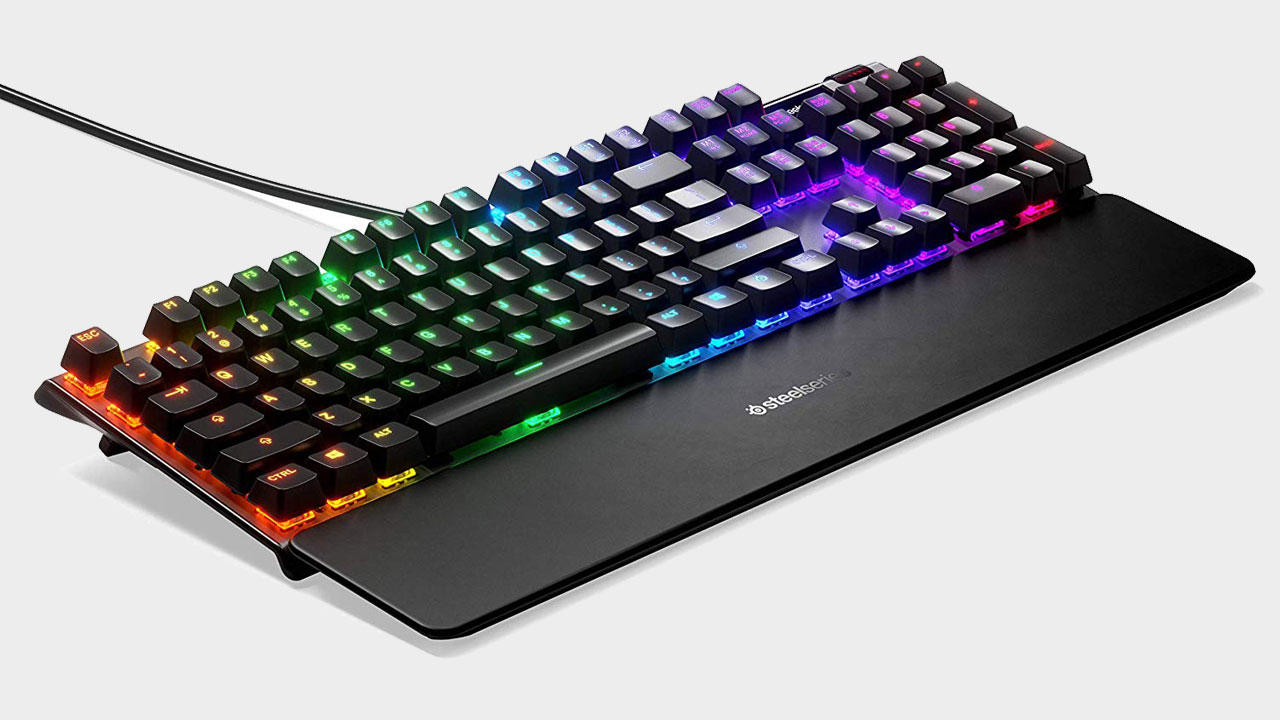
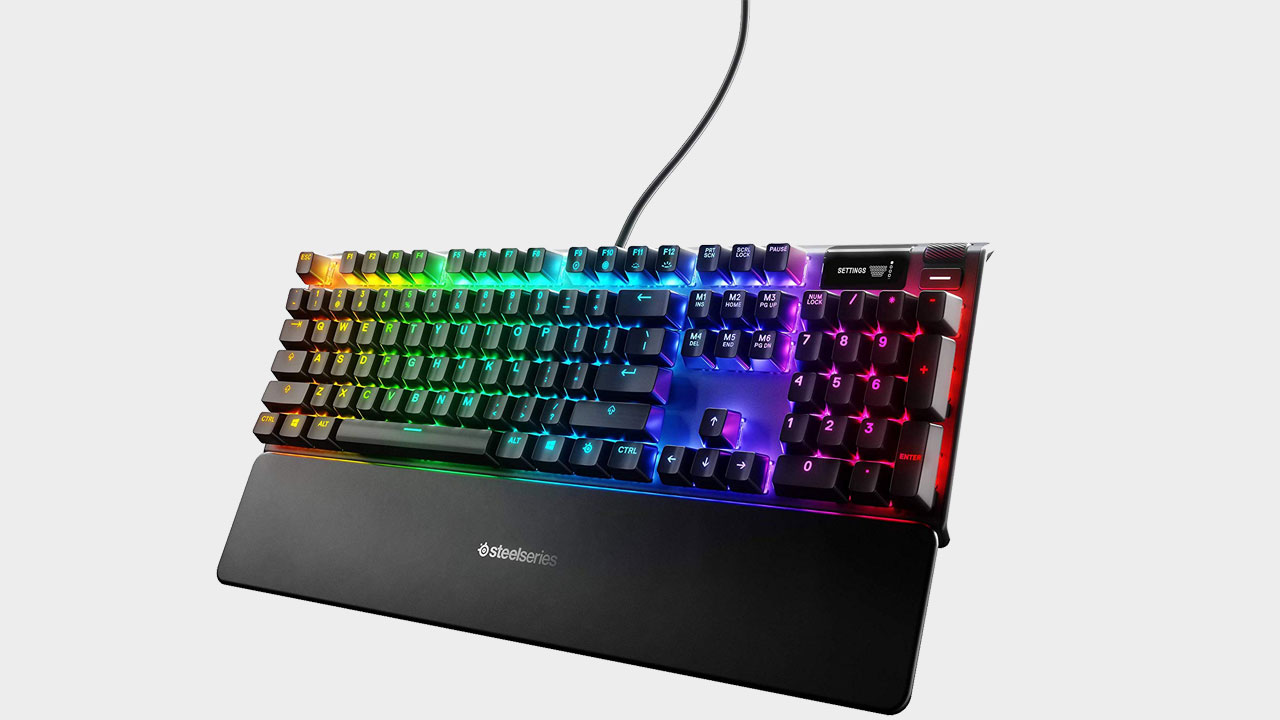
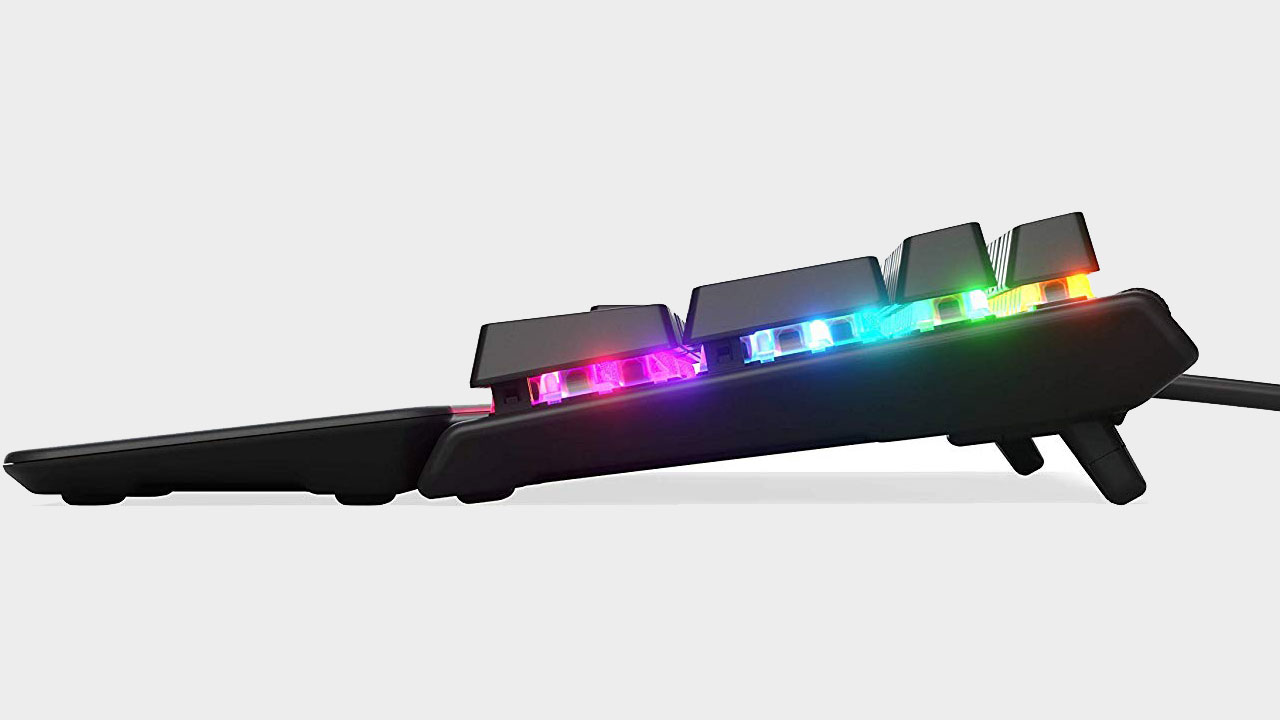
The Apex Pro may be built around one headline feature (its ability to set the actuation point for every key individually). Still, it's also an incredibly solid, competitive gaming keyboard even without that groundbreaking customization. That said, adjusting the actuation point on a key-by-key basis is an incredible boon, particularly for anyone that splits their time between typing and gaming.
If you find you struggle to decide between a linear and tactile switch, the Apex Pro offers you a hybrid that can satisfy both needs in the same model. Set a deeper actuation for typing or higher when you need to spam keys in a MOBA or MMO. Or if you find you're frequently nailing a particular key by accident and blowing your cooldown, you can set it individually to require that you bottom out, so you'll really need to push it with intention.
The Apex Pro also features a novel OLED display in the upper right-hand corner of the board, which lets you alter the actuation (though only across the entire board uniformly; the per-key settings require the SteelSeries Engine software), handle media controls, or even display a tiny animated gif. While it's more gimmick than a necessity, it does let you alter some key settings without having to dig deep into a separate software suite. And the low profile of the chassis with the heightened keycaps contributes to a beautiful aesthetic, with little to no wasted space around the board's edges.
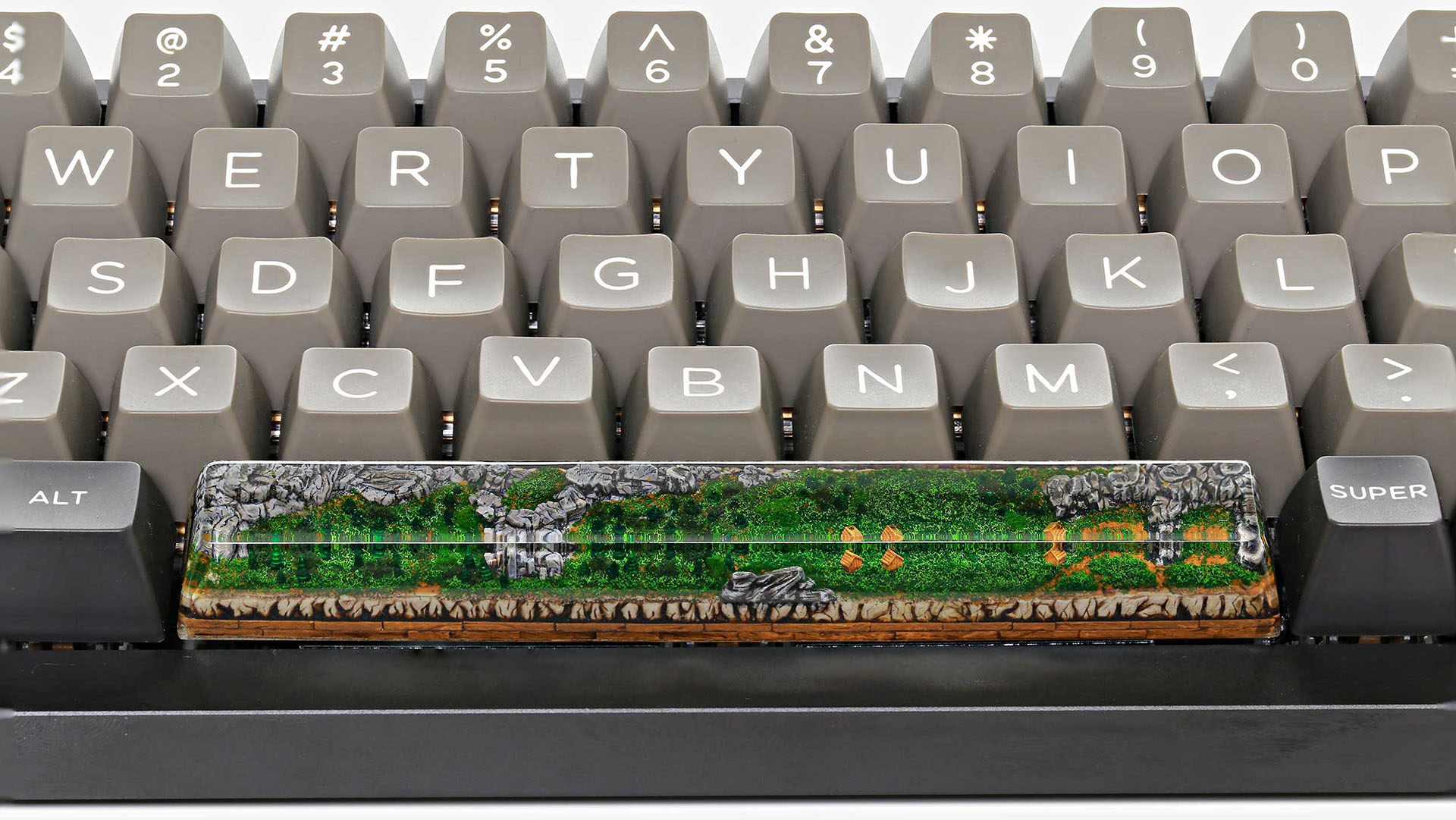
Gaming keyboard Q&A
Q. What is the big deal with mechanical switches?
A. We can talk for hours about the feel of mechanical switches versus membrane switches, but ultimately that's a personal choice. What makes mechanical switches objectively superior, however, is there far extended life span. They can take far more punishment and keep responding long after a membrane switch has collapsed in on itself.
Q. What is the most important thing to look for in a mechanical gaming keyboard?
A. The switch type is arguably the most important choice to make when picking your new gaming keyboard. Cherry mechanical switches are the most common and most recognizable, but there are a host of alternatives on offer, as well a bunch of upmarket, specialist switches to choose from.
Q. Are dedicated media controls a deal-breaker?
A. Only you can make that call, but we would suggest that at least having the option to toggle the top row between function and media controls would be our choice. Having a discrete volume wheel can be super useful, however.
Q. What size of keyboard do I need?
A. Keyboard size is absolutely a defining factor. Full-sized keyboards tend to offer the most features and a Numpad, but if you don't have space, then all of those extras you paid for will be useless. Tenkeyless boards (the ones with no number pad), and compact keyboards can be a great option too if you don't care about all the extra bells and whistles, or you don't have any use for alt codes (how barbaric!).
Jargon buster - keyboard terminology
Actuation Point
The height to which a key needs to be pressed before it actuates and sends an input signal to a device.
Clicky
A switch that delivers an audible click every time it's pressed, generally right around the point of actuation.
Debounce
A technique to ensure that only one input registers every time a key is pressed.
Housing
The shell that surrounds the internal components of a switch.
Hysteresis
The result of the actuation point and reset point in a switch being misaligned. This generally means a key needs to be lifted off further than normal before it can be actuated again.
Linear
A switch that moves directly up and down, generally delivering smooth keystrokes without noise or tactile feedback.
Mechanical Keyboard
A keyboard built around individual switches for each key rather than a membrane sheath mounted on a PCB.
Membrane Keyboard
A keyboard on which all the keycaps are mounted on a membrane sheath; when a key is pressed, a rubber dome depresses and pushes against the sheath and PCB beneath, actuating the key.
Stem
The component of a switch on which the keycaps are mounted on a mechanical keyboard.
Switch
The physical component of a mechanical keyboard beneath the keycaps on a mechanical keyboard. The switch determines how a key is actuated, whether or not it provides audible or tactile feedback with each press, and more.
Optical switch
This is a type of mechanical switch which instead of a physical metal contact switch uses light to measure when actuation takes place. These can be more configurable too, allowing for not just off and on states, but more analog designs, and even dual actions for a single key depending on how far the switch is pressed down.
Tactile
A switch that provides a 'bump' of feedback every time it's pushed.
Tenkeyless (TKL)
A keyboard that lacks the right-hand number pad.
from PCGamer latest https://ift.tt/3ftiqEY
The best gaming keyboard for your setup will mean understanding your typing needs and preferences deeply before you buy. Beyond basic beige scissor switches, in the realm of more advanced mechanical boards, you're looking at an entirely new level of gaming experience. Once you find your perfect fit, every interaction with your PC will leave you brimming with phenomenological delight.
There are keyboard switches in all flavors and colors, so here's the skinny on the best mechanical keyboard switches around.
The sweet, slick key press of your favoured mechanical switch will have your fingers feeling less fatigued, your response times swifter, and your key presses more absolute. There's also room for much more personalisation than a rubber dome keyboard could deliver. From smooth linear action, to typewriter-esque click clacks, and a range of RGB lighting configurations, there's something for everyone in the land of mech boards.
We've been over what style of keyboard is right for you, so check that out if you're tossing up between a full-size, TKL, or 60 percent board. There are countless combinations, but these are our pick for the best gaming keyboards you can buy today.
Alternatively, if you can't quite justify the cost of one of these bad boys, the best cheap gaming keyboards wont break the bank, but you may find them lacking the competency you'll find here.
Best gaming keyboards 2021




When you want to go the extra mile and upgrade to the absolute best of the best, it's hard to find a more premium option than the Corsair K100 RGB. Be warned, though; this is a big keyboard: its enormous footprint still requires some desk clearing before it can be nested comfortably. But feature-wise, the K100 RGB's got it all. Dedicated media controls and a USB pass-through, a metal volume wheel, RGB lighting. Speaking of RGB, there is an aggressive amount of RGB in this keyboard.
During our tests, we noted excellent key responses, a decent spread of keys for most hand sizes, a satisfying tactile click to each press, and wonderfully dimpled keys to help you rest your fingers when you're not actually pressing down. While this all seems quite obvious, it shows that the K100 RGB nails the basics, as well as including the fancy extras, and that's why it's top of the list.
Read the full Corsair K100 RGB Optical review.




All things to all people, that's almost what the Mountain Everest Max gaming keyboard represents. And it's one of my favourite designs since it first landed on my desk. I don't always need the numpad on a full-size keyboard, but it certainly comes in handy sometimes during the work day. When I'm gaming though, all I want is a compact TKL board, to get my mouse and keyboard hands closer together and give me more desktop real estate to fling around my rodent.
That's what the Everest Max offers; the flexibility to have your TKL cake and eat your numpad. Use your numpad. Whatever. Basically the magnetically attaching numpad module is able to be attached to either side of the base mechanical TKL board and is completely hot-swappable.
The admittedly very expensive $270 (£230) complete Everest Max kit also comes with a plush magnetic wrist rest and a media module with discrete controls and an LCD screen.
It's also a board for the keyboard enthusiast too, with a base that allows you to pull out switches at will and replace them as easily as just pushing them in. You can also go for the barebones board, picking your own switches and keycaps from the start to create a truly custom option.
My only reservations with the Everest Max are its high price and the initial immaturity I experienced with its config software. That's been ironed out now for the most part, and I'm still using my sample on a day-to-day basis as it totally suits how I game and work on my PC.
Read the full Mountain Everest Max review.


If even mecha-membrane keys don't suit you, and you demand a full membrane typing/gaming experience, the Razer Cynosa is the deck for you. I know there are people out there who prefer the soft embrace of a pure membrane switch, and that's fine—each to their own.
The Cynosa has some of the best feeling, low profile membrane keys I've ever tested, and at a retail price of $60, is one of the most affordable gaming keyboards out there (well, past a certain threshold of quality). While it may lack some of the features several gaming boards pack in these days, stuff like a dedicated wrist rest or media controls, it does boast Razer's extensive RGB lighting, which can be programmed on a per-key basis or applied by zones.
It's a solid, no-frills, nice looking keyboard that's the best membrane option of a huge range that I've tested. There is a step-up version of the Cynosa available. Still, for $20 extra, the only real addition is under-glow RGB, so unless that kind of 'ground effects' package is massively appealing to you, I recommend you save your cash and invest in the base model.

There is a trend towards $200+ gaming keyboards in the market at the moment, but that doesn't mean there aren't quality mechanical switch boards available at a more reasonable price. Often you'll find these more budget oriented options offering cheap switches from other manufacturers, but the G.Skill KM360 comes featuring the classic Cherry MX Red linear switch out of the gate.
If you can't cope with your gaming board not lit up like a rainbow then you may be disappointed with the single-colour option, but damn, the white LEDs on this G.Skill board are the brightest I've ever seen. Normally I like to keep at max brightness all day long, but the KM360 would burn out my retina if I did.
This TKL board is basic, but what it does, it does very well. It's solid, well-built, reliable, and looks pretty decent too. There's no wrist rest, no passthrough, or media controls, but I'll happily give it a pass in favour of affordable functionality.

If you must pick up a wireless keyboard then the Logitech G915 is a fine candidate. You'll be required to spend that little bit more for wireless functionality over what we tend to see for wired mechanical keyboards with similar features—the Logitech G915 is $250 (£210). There's a slightly cheaper TKL version, but not so much so that we'd instantly recommend it over the full-size model.
What you get for that significant cash investment is a sleek and sturdy board plated in brush aluminium. There's some smart media controls in the upper right-hand corner of the board, including a lovely volume wheel, and there's a handful of macro keys down the left-side of the keyboard. These can be programmed to whatever you see fit on a per-app or per-game basis from within the Logitech G software.
Beneath that stylish exterior lies fantastically responsive Kailh-made GL key switches. You can pick from linear, tactile, or clicky, and we recommend the latter if you really want to make a racket.
It packs in all this without massive overall footprint, too, coming in as one of the sleeker boards of the lot today. The wired Cherry MX 10.0 has it beat there, though, for better or worse.





For a board that can be illuminated in up to 16.9 million colors, the HyperX Alloy Elite sports a relatively simple aesthetic while still packing the features we expect out of a quality gaming keyboard. It comes in your choice of Cherry MX Brown, Blue, and Red. What it lacks in a dedicated macro column, it makes up for with its reasonable price and quality, durable design.
The HyperX Alloy Elite RGB leaves no feature box unchecked. It's equipped with dedicated media controls, USB passthrough, a detachable wrist-rest, and full RGB backlighting. It also includes an extra set of silver keycaps for WASD and the first four number keys to up its aesthetics. The board supports full N-key rollover, meaning you never have to worry about key presses not registering.
The new HyperX Alloy Elite 2 has now been launched, featuring some gorgeous ABS pudding keycaps, but only seems to be available on the HyperX website right now. It is damned pretty, but you don't get the wrist rest... you win some, you lose some.
Best gaming mouse | Best gaming chair | Best gaming PC
Best VR headset | Best wireless gaming mouse | Best gaming monitor



The original Freestyle Edge from Kinesis was one of the best split ergonomic keyboards on the market. This upgraded RGB model improves on the original in several ways. It retains the split design, allowing you to set the deck's two halves at shoulder width and reduce back, neck, and shoulder strain. The gap also lets you drop a flight stick or HOTAS in between them for space sims or leave your controller within easy reach when you're typing in text chat or messengers between sessions.
The Freestyle Edge RGB is also customizable, with onboard storage for up to nine user profiles, ten dedicated macro keys on the left half, and the ability to customize every key individually (including on the entire layer that you access by pushing the Fn key). It's fully programmable without the use of any additional software, though it can also be customized through Kinesis' Smartest software for an even more granular experience.

The Huntsman family of Razer keyboards is the only place in the world to find their optomechanical switch, and it's one of the best (and most technologically interesting) switches on the market. The optomechanical build eschews traditional metal contacts and instead actuates by a beam of light that fires through the switch when the key is depressed, meaning actuation is almost instantaneous.
The other major advantage of removing all the relatively frail, slender metal contacts from the switch is that they're rated as twice as durable as standard mechanical switches, up to 100 million keystrokes. They're tactile switches that actuate at 1.5 mm and 45g of force, meaning they're ridiculously easy to spam but still provide tactile feedback. They're also great for typing for much the same reason.
The rest of the Elite is well designed too, with a comfy detachable magnetic wrist rest, a full suite of dedicated media controls, and a multi-function dial that can be used for anything from altering your PC's volume to scrolling through lighting suites for the 16.8 million RGB color options. It also features some handy storage on the keyboard, so you can easily save your preferences to a profile that will travel with you if you move it to a different machine. It's an excellent, fully-featured keyboard with some truly fantastic switches, though you'll pay a premium for the privilege of using them.
Read the full Razer Huntsman Elite review.



The Apex Pro may be built around one headline feature (its ability to set the actuation point for every key individually). Still, it's also an incredibly solid, competitive gaming keyboard even without that groundbreaking customization. That said, adjusting the actuation point on a key-by-key basis is an incredible boon, particularly for anyone that splits their time between typing and gaming.
If you find you struggle to decide between a linear and tactile switch, the Apex Pro offers you a hybrid that can satisfy both needs in the same model. Set a deeper actuation for typing or higher when you need to spam keys in a MOBA or MMO. Or if you find you're frequently nailing a particular key by accident and blowing your cooldown, you can set it individually to require that you bottom out, so you'll really need to push it with intention.
The Apex Pro also features a novel OLED display in the upper right-hand corner of the board, which lets you alter the actuation (though only across the entire board uniformly; the per-key settings require the SteelSeries Engine software), handle media controls, or even display a tiny animated gif. While it's more gimmick than a necessity, it does let you alter some key settings without having to dig deep into a separate software suite. And the low profile of the chassis with the heightened keycaps contributes to a beautiful aesthetic, with little to no wasted space around the board's edges.

Gaming keyboard Q&A
Q. What is the big deal with mechanical switches?
A. We can talk for hours about the feel of mechanical switches versus membrane switches, but ultimately that's a personal choice. What makes mechanical switches objectively superior, however, is there far extended life span. They can take far more punishment and keep responding long after a membrane switch has collapsed in on itself.
Q. What is the most important thing to look for in a mechanical gaming keyboard?
A. The switch type is arguably the most important choice to make when picking your new gaming keyboard. Cherry mechanical switches are the most common and most recognizable, but there are a host of alternatives on offer, as well a bunch of upmarket, specialist switches to choose from.
Q. Are dedicated media controls a deal-breaker?
A. Only you can make that call, but we would suggest that at least having the option to toggle the top row between function and media controls would be our choice. Having a discrete volume wheel can be super useful, however.
Q. What size of keyboard do I need?
A. Keyboard size is absolutely a defining factor. Full-sized keyboards tend to offer the most features and a Numpad, but if you don't have space, then all of those extras you paid for will be useless. Tenkeyless boards (the ones with no number pad), and compact keyboards can be a great option too if you don't care about all the extra bells and whistles, or you don't have any use for alt codes (how barbaric!).
Jargon buster - keyboard terminology
Actuation Point
The height to which a key needs to be pressed before it actuates and sends an input signal to a device.
Clicky
A switch that delivers an audible click every time it's pressed, generally right around the point of actuation.
Debounce
A technique to ensure that only one input registers every time a key is pressed.
Housing
The shell that surrounds the internal components of a switch.
Hysteresis
The result of the actuation point and reset point in a switch being misaligned. This generally means a key needs to be lifted off further than normal before it can be actuated again.
Linear
A switch that moves directly up and down, generally delivering smooth keystrokes without noise or tactile feedback.
Mechanical Keyboard
A keyboard built around individual switches for each key rather than a membrane sheath mounted on a PCB.
Membrane Keyboard
A keyboard on which all the keycaps are mounted on a membrane sheath; when a key is pressed, a rubber dome depresses and pushes against the sheath and PCB beneath, actuating the key.
Stem
The component of a switch on which the keycaps are mounted on a mechanical keyboard.
Switch
The physical component of a mechanical keyboard beneath the keycaps on a mechanical keyboard. The switch determines how a key is actuated, whether or not it provides audible or tactile feedback with each press, and more.
Optical switch
This is a type of mechanical switch which instead of a physical metal contact switch uses light to measure when actuation takes place. These can be more configurable too, allowing for not just off and on states, but more analog designs, and even dual actions for a single key depending on how far the switch is pressed down.
Tactile
A switch that provides a 'bump' of feedback every time it's pushed.
Tenkeyless (TKL)
A keyboard that lacks the right-hand number pad.
via IFTTT

Post a Comment